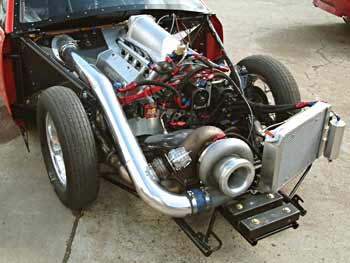By David Anderson
12/16/04
While a great deal of off-season news flows
like a river from the various motorsports media outlets,
few newsbytes have created as much talk as the TLR/AMS Pro
Modified Series allowing turbocharged combinations the opportunity
to compete in sanctioned competition for the first time in
history.
In addition, the rule-makers also have given the blower combinations the chance
to make a drive for regular low 6-second passes and the occasional 5-second
pass by allowing them 29 percent overdrive instead of the 20 percent they were
required to run this year in both NHRA and IHRA competition.

Having been crew chief
for Lawrence Conley, who has campaigned Turbo
Buicks and now a Twin Turbo big block Chevy
for a number of years, I can offer an insider's
look into what it takes to campaign one of
these combinations.
To many diehard
fans, the turbo and fuel injected combination
may look like something out of a science
fiction movie. On appearance alone, some
turbo cars may have more plumbing than the
Empire State Building, and the box that controls
the EFI system could be viewed as "black
magic."
Read
More (Click Here) |
|
Several racers ran 6.10 at 20 percent overdrive and 2700 lbs. last season.
Adding almost 50 percent more overdrive and taking a hundred pounds off some
blown cars almost guarantees five-second ETs.
And in an effort to foster the continued participation of the Nitrous contingent,
the rules on cubic inch displacement have been lifted and there are no restrictions
on engine size and the minimum weight has been reduced to give the laughing
gas diehards a shot at the pot of gold at the end of the rainbow, too.
As a result of the rule changes it appears the differential in combinations
is going to be sufficient enough that it will make it much more difficult for
the lower financed teams to run in both series. This reminds me of the split
between IRL and CART many years ago.
While many fans appreciate the close side-by-side racing of a class such
as NHRA Pro Stock, there never seems to be a shortage of fans that will start
screaming when a Top Fuel car puts a huge number on the score board even
if the guy in the other lane smokes the tires. Simply put, many spectators
are looking for that seemingly impossible number to show up on the score
board. It’s been that way since the beginning of drag racing.
They said 150 was the limit, then that 200 would never be broken, then 250
and 300 and so forth. For many years 6 seconds and 200MPH was the magic number
combo for a doorslammer. Now even in Pro Stock those numbers are as plain as
peanut butter and jelly.
 While the 5-second barrier was broken by Mitch Stott in Darlington in 2003,
that still appears to be the magic number for doorslammers. Just imagine the
crowd reaction at the first event where a Pro Mod rips off a 5-second ET or
runs over 240MPH. That place will erupt like Mount St. Helens. While the 5-second barrier was broken by Mitch Stott in Darlington in 2003,
that still appears to be the magic number for doorslammers. Just imagine the
crowd reaction at the first event where a Pro Mod rips off a 5-second ET or
runs over 240MPH. That place will erupt like Mount St. Helens.
A recent Quick 8 event at a brand new facility that didn’t
have score boards up yet illustrates the point. Fans knew who won,
but a delay in communicating the ETs via the PA system seemed to
take away from what the initial reaction would have been watching
a record breaking side-by-side race.
|
